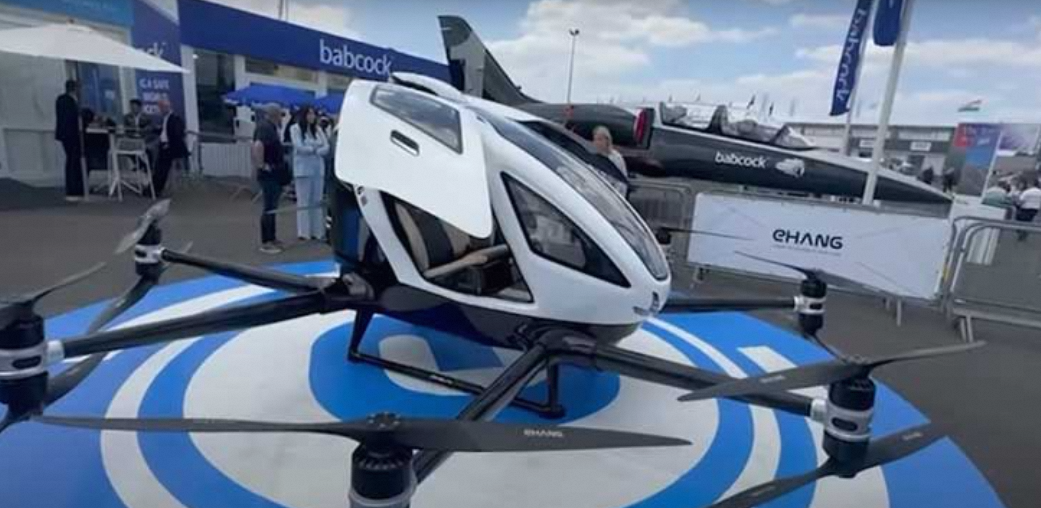In a significant leap forward for the future of urban mobility, China unveiled an unmanned air taxi at the prestigious Paris Air Show. The introduction of this cutting-edge aerial vehicle marks a pivotal moment in the development of autonomous aviation technology. Drawing attention from global aerospace leaders, the air taxi represents China’s growing influence in the field of advanced transportation and innovation.
Unmanned Air Taxi: A Glimpse Into the Future
The air taxi, designed and manufactured by a leading Chinese aerospace technology company, is a fully electric, vertical take-off and landing (eVTOL) aircraft. Built to carry two passengers, it can operate without a pilot, relying instead on an integrated artificial intelligence system for navigation, flight control, and safety management.
Equipped with multiple rotors and powered by a rechargeable battery system, the aircraft is designed for short-distance urban flights. Its maximum range is approximately 35 kilometers, and it can cruise at speeds of up to 130 kilometers per hour. With zero emissions and low noise levels, it offers a sustainable alternative to conventional ground transportation, particularly in congested city environments.
Features and Specifications
The Chinese air taxi features a compact design optimized for vertical mobility, enabling it to land on rooftops, parking lots, and other restricted urban spaces. Safety remains a top priority, with the vehicle incorporating multiple layers of redundancy, including backup batteries, flight control systems, and automated emergency landing protocols.
Advanced sensors, radar systems, and high-definition cameras allow the aircraft to detect obstacles, monitor weather conditions, and navigate with precision. Its autonomous flight capabilities are supported by real-time communication with a centralized control hub, which can intervene in case of unexpected system behavior or emergency situations.
Passenger safety and comfort are also key design elements. The cabin is enclosed, climate-controlled, and fitted with secure seating and real-time communication interfaces that allow passengers to receive flight updates and contact ground support if necessary.
Showcasing at the Paris Air Show
The unveiling of the air taxi at the Paris Air Show attracted significant international attention. As one of the largest aerospace exhibitions in the world, the event served as an ideal platform for showcasing emerging technologies and engaging with global stakeholders. The Chinese delegation conducted multiple demonstrations and presentations, outlining the design, capabilities, and long-term vision for the air taxi.
Delegates from various countries, including representatives from aerospace regulators, urban planning authorities, and transport technology firms, showed keen interest in the vehicle’s commercial potential. The Chinese company emphasized its intention to partner with international cities and mobility providers to conduct trial runs and integrate air taxis into future urban transport ecosystems.
Implications for Urban Mobility
The introduction of the unmanned air taxi underscores the broader shift toward smart cities and next-generation mobility solutions. With growing concerns over traffic congestion, pollution, and inefficient transportation infrastructure, autonomous aerial vehicles present a compelling alternative.
Urban air mobility, once a concept confined to science fiction, is now being actively developed by governments and private companies around the world. China’s initiative signals its commitment to leading in this sector, leveraging advancements in artificial intelligence, battery technology, and aviation engineering.
By reducing reliance on traditional road systems, air taxis have the potential to revolutionize commuting in densely populated urban areas. They can serve not only individual passengers but also play roles in emergency medical services, disaster response, and cargo delivery.
Global Competition and Regulatory Outlook
China’s move into the air taxi market places it among a growing list of countries racing to develop and commercialize unmanned aerial transport. Companies in the United States, Europe, and the Middle East are also testing similar technologies, and international competition is intensifying.
Regulatory frameworks, however, remain a critical challenge. Authorities must address air traffic integration, safety standards, public acceptance, and data security before unmanned air taxis can be deployed widely. Chinese officials have indicated that coordination with international aviation bodies will be essential to ensure compliance and safety in cross-border applications.
Future Prospects
The Chinese air taxi project is part of a broader strategy to position the country as a leader in smart transportation. Future versions of the vehicle may feature extended range, higher passenger capacity, and enhanced AI capabilities. With continued investment and technological refinement, unmanned air taxis may soon become a routine sight in urban skies, transforming the way people travel within cities.
